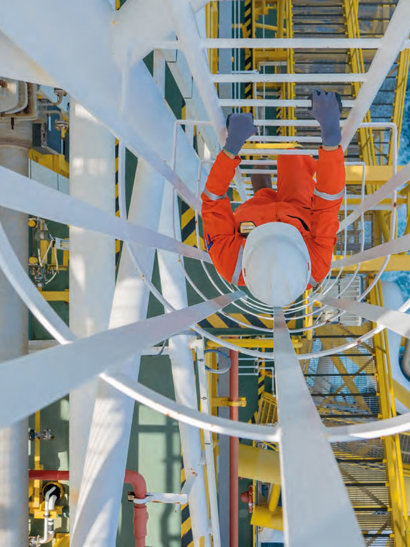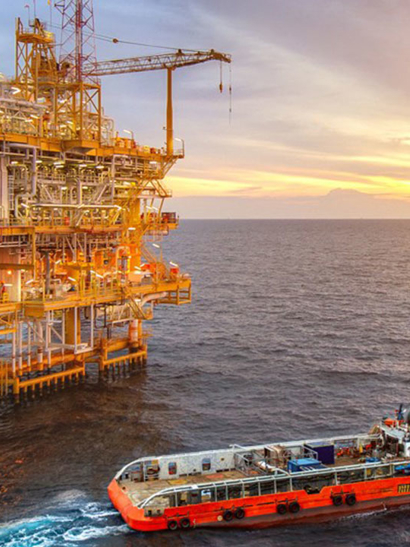For offshore business to invest and drive decarbonisation, we need clarity on policies for the future and so far, these have not been clearly set out by governments. Companies require clear and viable business models before they can make investment decisions on behalf of shareholders. At $70 a barrel (currently approaching $100), energy firms may well be able to afford to factor in the costs of electrification and carbon capture and storage (CCS), but they need assurance that business models will be fit-for-purpose in the future. There is a lack of clear policy and the energy sector is left facing unknown risks.
At the much lower prices that we have seen over the last few years, the expense of electrification or CCS could make the difference between profit and loss. And let’s be clear, contrary to some views, investment in these technologies is no longer a corporate social responsibility issue, it’s about having a sustainable business now and in the future. This is a change of mindset that I think many people still have to understand.
The easy option
I believe that part of government reticence is because it’s politically easier to support green energy initiatives in the current climate, rather than cutting the carbon footprint of existing hydrocarbons infrastructure. But we still need energy from oil and gas and will do for many years to come. And renewable energies of various types do not provide a complete energy option in every location.
Of course, we must adopt sources of sustainable energy that make commercial sense but, especially after the outcomes of COP26, we need policies that support the energy transition and underpin investment decisions. We still need long-term policies that generate growth and business success. Governments need to get off the fence.
Energy security is the top priority, particularly as economies recover following the pandemic. Increasing our reliance on energy imports is not a prudent strategy in my view, for several reasons. One, secured energy supplies are a vital component of a healthy economy. Two, imported oil and gas may have a larger carbon footprint than that produced locally. And three, secure supplies depend on “friendly” states and sound international relationships. We have seen the impact of reduced energy security and fragile international relationships in 2022 already, evidenced by rising oil and gas prices.
Long-term certainty
In the short- to medium-term, therefore, CCS is a promising technology – in fact, it’s a win-win for most energy businesses. And it enables governments to continue to support oil and gas businesses because energy produced with CCS is broadly equivalent, in lifecycle emission terms, to renewable energy sources. It has the potential to reduce carbon emissions by 80-95%.
But to undertake investment, companies have to be certain that CCS is an acceptable option in the long term, and not be told in five years by governments that it’s not a favoured strategy anymore. I believe that part of this reticence is because it’s politically easier to support green energy initiatives in the current climate, rather than cutting the carbon footprint of the existing hydrocarbons business.
CCS can be more cost effective than electrification, but it still doesn’t make sense at an individual facility level. The carbon capture component can be adopted at each facility, but the storage and/or use component needs to be organised in a wider framework. Where pipelines are not available, we will need ships to take the carbon captured to storage hubs. This could involve the re-purposing of LPG carriers, or newbuilding of LCO2 carriers for example.
We have seen increasing collaboration between energy firms over the last five years and if CCS systems can be put in place covering several facilities, we will need to make the most of this cooperation. Operators need to work together, and we need to see clarity from governments.

Fair competition
Another important aspect here is that if energy firms in the North Sea, for example, adopt CCS to meet decarbonisation aims, the gas could well have a higher unit cost than gas supplies from other parts of the world that don’t have these systems in place. Therefore, CCS could become a ‘penalty cost’ for operating in this region.
Meanwhile, we shouldn’t forget that in the UK, for example, only three storage well sites around the coast have been identified so far that are geologically suitable and approved for long-term carbon storage. These are Liverpool Bay, and regions off the coast of Peterhead, and Newcastle further south. It is expected we could see an 800 fold increase in global CO2 storage capacity to meet the demand for storing captured CO2.
On electrification, we are already seeing collaboration between energy companies. Last year, BP, Harbour Energy, Shell and TotalEnergies announced that they would work together on a major electrification project in the central North Sea. This is exactly the collaborative strategy that is necessary but again, such initiatives should be supported by government with clear policies that will ensure there is a long term future in the sector to offset such a large capital investment.
In the UK, we need to generate more electricity and our electrical networks are not capable of handling large increases in demand associated with, for example, a substantial move to electric vehicles. So, infrastructure upgrades will be required – this will take time. We need to ensure that our ambition to achieve net-zero does no overwhelm what is already a fragile network.
The potential of Power-to-X
Clearly, in the longer term, we need to continue with the development of alternative energy sources. At LR, we believe that Power-to-X (P2X) technology and the development of low- or zero-carbon fuels, notably Hydrogen, Ammonia and Nuclear, offer great opportunities. We are closely involved in the EMR Dolphyn project, a P2X technology which offers great scope for major advances in carbon-free energy generated from renewables in the future.
The world urgently needs new technologies like P2X to work because the need to cut our dependence on carbon-heavy energy is urgent. But to make new energy options – like P2X – successful, we need business models that make sense, and which shareholders such as pension funds and other capital providers can understand and rely on, not just for five years, but for half a century and more.
After COP26, from which, despite some disappointments, there have been some positive outcomes, it is clear that energy companies must tackle today’s essential and urgent transition without delay. At LR, we are determined to support enterprise where there is a clear business case and a model that earns a return for companies and their shareholders.
"In the UK, we need to generate more electricity and our electrical networks are not capable of handling large increases in demand associated with, for example, a substantial move to electric vehicles."

No quick fix
There is no question that the world will need oil and gas for many years to come, but there are technologies to cut the carbon footprints whilst, at the same time, we develop new energy sources that are carbon-neutral or entirely green. In the hydrocarbon sector, there is substantial scope to reduce greenhouse gas emissions by decarbonising the energy production process. And there are already oil and gas fields in the North Sea and the Arabian Gulf which are powered by sustainable energy from shore or offshore wind.
There are exciting projects and we are at the forefront of supporting them with our long assurance knowledge and expertise. But there are no simple options. Take offshore wind, for example. The development of offshore wind farms – both fixed-bottom installations in relatively shallow waters close to shore, and now floating facilities in deeper waters where the wind blows more persistently – is providing significant volumes of renewable energy in many regions.
But this energy source has drawbacks too. The construction and installation process puts pressure on the marine environment, large exclusion zones are required around wind farms, and so far at least, old turbine blades which need replacing cannot be recycled. And let’s not forget, the wind doesn’t blow all the time, so we need either energy storage at sea or at reception facilities ashore if we want to be able to charge our electric cars at the end of the day.
Battery technology is developing fast. But current technologies require small amounts of rare metals of which supplies are finite. In future, we will have to scour the planet high and low and, at some point, search the seabed; an activity that can place significant stress on the fragile marine environment and will need to be managed appropriately. There are gains and losses to manage in the decarbonisation process.
In conclusion, I would like to stress the importance of today’s energy majors – with decades of experience in oil and gas – working closely with the developers of new power sources. Together, they can save time, use past experience, and probably cut development costs. But to do so, they need greater support from policy makers and a clear regulatory framework. LR will continue to support the policy makers and industry in navigating the challenges and opportunities of the energy transition with an independent and trusted voice in the Energy sector.








